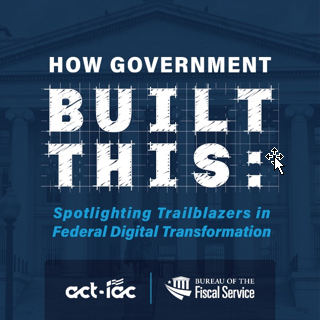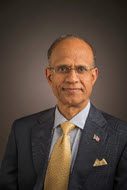

‘How Government Built This’ Innovation Spotlight: How USDA is Paving the Way for Digital Transformation

Welcome to “How Government Built This,” a six-part podcast and blog post series developed by the Department of the Treasury’s Bureau of the Fiscal Service Office of Financial Innovation and Transformation (FIT) in collaboration with the American Council for Technology and Industry Advisory Council (ACT-IAC) a non-profit educational organization established to improve government through the effective and innovation application of technology. This series spotlights trailblazers in Federal digital transformation. Resources and links mentioned in each podcast will also be available at actiac.org/thebuzz.
 Dr. Michael Valivullah, Chief Technology Officer, Research, Education and Economics (REE), United States Department of Agriculture (USDA)
Dr. Michael Valivullah, Chief Technology Officer, Research, Education and Economics (REE), United States Department of Agriculture (USDA)
Michael is currently serving as the Chief Technology Officer (CTO) at the U.S. Department of Agriculture’s (USDA) Research, Education and Economics mission area covering four USDA agencies (Agricultural Research Service (ARS), Economic Research Service (ERS), National Institute of Food and Agriculture (NIFA), and National Agriculture Statistics Service (NASS)). Dr. Valivullah has served twenty years in the public sector and fifteen years in private industry and in the non-profit sector.
What is digital transformation?
Michael’s perspective of digital transformation is informed by the cultural, industrial, and digital revolutions. He described digital transformation as data, in all of its forms. Michael pointed to the fact that today organizations use two to three percent of their data while the rest is not mined or assessed. Therefore, for a successful transformation to take place, the data must be accessible.
What is the role of emerging technologies in digital transformation?
When it comes to emerging technologies, Michael noted that cloud computing is the electricity for digital transformation initiatives. At USDA, the NASS is the true data keeper for USDA. In fact, Michael noted that USDA has been collecting data across many of its mission areas for over 150 years now and every five years USDA conducts a census. Today, data collected by USDA is informing unmanned aerial systems which are supported by algorithms and neural networks to analyze and visualize data.
Michael highlighted that each year USDA conducts over a thousand surveys with over 400 reports published every year supported by hundreds of statisticians. While data is critical to USDA’s efforts, Michael shared that asking farmers for permission to collect key data can help to reduce respondent burden for various USDA data collection efforts. As USDA continues to collect this data, Michael also mentioned the agency has a large focus on ensuring operations are effective and efficient for American citizens who participate in these data collection efforts.
The importance of people
For digital transformation initiatives across government, people and teams are central to the conversation. Michael outlined that USDA is focused on upskilling and reskilling the agency’s workforce by:
- Identifying the skills sets needed in the immediate term versus the long term;
- Developing people and teams who can provide exceptional customer service to the American public; and
- Instituting measures across the USDA enterprise that drive organizational excellence.
Michael noted that USDA reassesses their human capital transformation plan annually to proactively help people decide where they would like to build their careers. USDA supports these efforts by also offering funding for online or in-person training and works closely with Federal internship and fellowship programs to recruit talented people and sustain their engagement with USDA through employment opportunities.
What are the challenges an organization may face when leading a digital transformation?
Michael emphasized that the inspiration for USDA’s digital transformation had to do with reassessing the agency’s operational model. Michael and his team asked questions such as:
- What business processes are optimal?
- Where can the agency take advantage of new technologies?
- How can the agency best serve American citizens?
In addressing these questions, Michael pointed back to the data and expressed that data validation routines, operations, and areas of automation can be identified to proactively address the questions outlined above. Michael also noted that good governance and protection of data is critical to these types of efforts. For example, market sensitive data cannot be revealed before it’s approved for public release.
With this, Michael walked through the goals USDA set for the agency’s digital transformation which includes:
- Focusing on security
- Reducing respondent burden
- Increasing operational efficiency
Michael highlighted that USDA reassessed their applications and their designs to determine which are and are not helpful. Once the applications were assessed, the applications were then moved to the cloud. Michael emphasized that having the right team to support these types of efforts is truly key to leading a digital transformation initiative. Michael also emphasized that the service providers and cloud architects who support USDA today are instrumental to the success of the effort. Ultimately though, Michael noted that proof of concepts or pilots help teams find what works and what doesn’t, and this is a part of the journey. Michael recommended that “if you find something that doesn’t work, just cut it loose and move forward”.
Advice for readers
Michael concluded the interview by recommending agencies and their teams set goals for what the end point of a digital transformation looks like. These goals can be identified through developing a proof of concept. Along with this, collaborating closely with vendors to learn the technology, as well as teaching vendors about an agency’s mission makes all the difference.
We would like to thank Michael once again for his time and willingness to participate in the "How Government Built This" podcast and blog series. We appreciate his strategic insight and enthusiasm for USDA’s digital transformation efforts and overall mission, and we hope everyone reading appreciates Michael’s insights and experience.
For questions, please e-mail the Department of the Treasury’s Bureau of the Fiscal Service FIT team at FIT@fiscal.treasury.gov.
References
- ACT-IAC Health Community of Interest (COI) White Paper “Policy Considerations for the Use of Synthetic Healthcare Data”
- Federal Insights Exchange (FIE) Chief Data Officer (CDO) Panel on September 7th from 10 AM to 11 AM. Register here
- For more information on ACT-IAC’s Emerging Technology COI’s CDO outreach initiative, please email actiacnucsl@gmail.com
